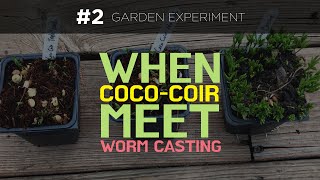How Coconut Coir Does Without Earthworm Castings
How Coconut Coir Does Without Earthworm Castings

In this video, you will see:
– What Earthworm Castings are
– If Coco Coir needs to be rinsed before use
– The result between only coco coir and coco coir with earthworm castings
BABOchon.com
coco coir for houseplants
Worm castings

I am thinking to use equal amount of coir to compost to grow vegetables inside a greenhouse. Would worm casing be a good idea to add too? Anything else I need to add? I heard tablespoon of lime too, thanks
Thanks for sharing
What can I use instead of worm castings.
Untreated (unbuffered) coco can release an abundance of potassium which in turn can cause magnesium (et al.) lockout due to its cation exchange capacity (CEC). It naturally has an abundance of potassium and sodium at the exchange sites, but virtually no magnesium or calcium. So when magnesium is introduced, it is adsorbed at the cation exchange sites, releasing the potassium and sodium, but the magnesium itself becomes unavailable for the plant. No magnesium = no chlorophyll = no growth. This is why properly treated coco coir is essential, especially when used for large, fast growing annuals.
You can either simply spend the extra money and buy the premium, pre-treated stuff found in hydroponic stores, or you can buffer it yourself easily enough. If it’s the compressed stuff, hydrate it first, then wring out as much water as you can. (Simply rinsing with water does nothing to release the potassium and sodium locked at the exchange sites, but it will remove the "free" potassium and sodium that may be present). Then mix up a batch of *double-strength* Cal-Mag solution, saturate the coir with it (make it soupy), and let it soak in this for 15 minutes. Much of the potassium and sodium will be released into solution as it is exchanged for the calcium and magnesium until an equilibrium has been established. Now drain this, reserving the water to fertilize your flowering plants around the garden (why waste all this potassium?), or hydrate your compost pile with it. Meanwhile, your buffered coir is ready for use.
Thanks for the video, though I would have liked to see examples of Coco Coir with varying amounts of Worm Castings mixed in to see if there is an optimal mix ratio. Again, thanks for the information!
Great video! How can I store extra hydrated coco coir? Can I store in a Tupperware or bucket
Love the video editing
Should have made a Coco with castings
Did you feed the coir or buffer it ?
I get my worm castings from VermisTerra, they are top quality. Their worms are only fed green vegetables.
Wait…were you feeding the plants? Cus coco coir has virtually zero nutritional value
Awesome. How much coco to how much worm castings to mix.
While "earthworm castings" works well for a fertilizer, it is important to know you should use the right kind of water: https://www.youtube.com/watch?v=CtcdDzlJ-9I